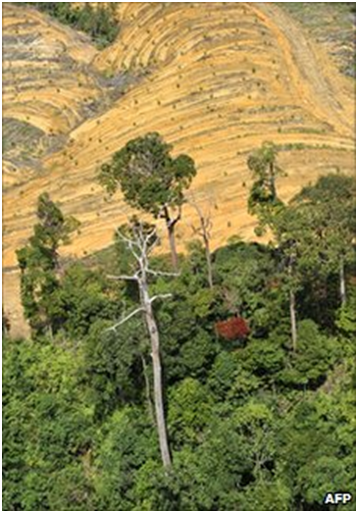Zimbabwe’s farmers struggle to feed the nation
Zimbabwe needs 1.8 million tonnes of the staple maize every year to meet the needs of its people and livestock. Only 798,500 tonnes were produced during the 2012/13 agricultural season. As a result, the country that was once dubbed “the breadbasket of the region” has to make up the deficit with imports and look to donors for food aid. After last year’s harvest, the World Food Programme, the UN food aid agency, forecast that an estimated 2.2 million people—equal to a quarter of the rural population—would need food assistance, from October 2013 through the early months of this year. Photo: Yosef Hadar / World Bank
The size of the maize harvests may vary, but this has been a familiar story since 2001, the last time Zimbabwe produced enough maize to meet its needs. Zimbabwe’s transformation from exporter to importer of food is blamed by some analysts on the land reform programme launched in 2000, which saw white commercial farmers lose farms to landless blacks who are said to lack the skills to farm at the same level as the previous white owners.
However, closer scrutiny reveals a more complex picture. According to the Commercial Farmer’s Union (CFU), the body that used to represent white farmers but is now open to all commercial farmers in Zimbabwe, up until 2001, a year after the launch of the “fast track” land reform, small-scale farmers produced the bulk of the country’s maize harvest. “Of the average 2 million tonnes of maize that used to be produced, more than half was grown by the [black] small-scale farmers,” says Richard Taylor, a CFU spokesperson. In 2001, small-scale farmers produced 1.2 million tonnes while the mostly white large-scale commercial farmers produced 800,000 tonnes. Over the years the commercial farmers’ contribution was consistent, as they irrigated their land, while that of the small-scale farmers depended on the vagaries of the weather.
Taylor blames a lack of financial support for the sector’s poor performance. He suggests the introduction of a scheme for small-scale farmers whereby they can borrow what they need from seed or fertilizer companies. “The farmers can pay back when they sell their crop and the loans should be guaranteed by the government.” He also sees land rights as an answer. “Farmers should have security of tenure so they can use their land as collateral when they apply for loans.” He describes the small handouts of seed packages and fertilizers given to vulnerable farmers by the government and nongovernmental organizations as unsustainable.
A senior official in the ministry of agriculture echoed Taylor’s sentiments. Speaking on condition of anonymity, he told Africa Renewal that a lack of support is not the only factor contributing to the country’s inability to produce enough to feed its own people. “People in certain areas of the country should not bother growing crops, as their land is not good enough and rainfall is erratic,” he said. The government divided the country into five agro-climatic or natural regions, depending on the rainfall each region receives. Crop production progressively deteriorates from one region to the other.
The official said that in the absence of irrigation, the best plan would be to get farmers to specialize in what works in their areas. He gave the example of drought-prone Beit Bridge in the southern part of the country, where farming is not profitable. “Even if they change to drought-tolerant small grains such as sorghum or millet, rainfall is so erratic in such places that those small grains may not survive the heat. They should focus on their cattle and goats, which they can sell to buy food,” he said. He added that the government was aware of this, but suspects it is reluctant to encourage the switch as it might have negative political ramifications. The people who have been growing maize, the staple for most Zimbabweans, may be less inclined to change their farming patterns.
Dr. Sam Moyo of the African Institute of Agrarian Studies also expressed concern over the lack of support for food production. “The only way food production can be improved is through subsidies,” he said, citing the example of Zambia, where subsidies have led to an increase in food production. Ironically, Zambia used to import grain from Zimbabwe.
Deputy agriculture minister David Marapira agrees that irrigation would go a long way towards ensuring increased productivity. “There are so many dams all over the country, but we are not making use of that water,” he told Africa Renewal. The sad truth, however, is that Zimbabwe currently has less land under irrigation than at the beginning of the land reform programme.
Last year the Herald, a government-owned daily newspaper, quoted Conrade Zawe of the Department of Irrigation in the Ministry of Agriculture as saying that about half of the 250,000 hectares of land under irrigation in 2000 were being irrigated in 2013. The government allocated $250,000 for the maintenance of irrigation schemes in 2013, but up to November of that year a measly $36,000 had been disbursed. The 2014 budget announced last December sets aside $138,000 for the same purpose. But analysts are not holding out too much hope; they point to the difference between what the government has said will be spent and what it has actually disbursed.
Paul Zakariya of the Zimbabwe Farmers Union says only a total revamp of the agricultural sector will bring about a return to the days when Zimbabwe produced enough to feed itself, and agriculture contributed some 40% of the country’s foreign currency earnings through exports. “What we need is agricultural finance that is packaged properly for agriculture in the various sectors, communal, small-scale commercial, large-scale commercial, and we’d also want to look at not only working capital but investments in infrastructure, like irrigation, like the feeder roads….”
Analysts say the government has to inject as much as $2 billion to get Zimbabwe’s agricultural sector producing enough to meet the country’s own needs. Yet because of the country’s dire economic situation, only $155 million was allocated to the Ministry of Agriculture in the 4.4 billion 2014 national budget. The ministry had requested $490.5 million. Prince Kuipa, chief economist with the Zimbabwe Farmers Union, pointed out that the amount is a mere estimate; going by past experience, the ministry is unlikely to get the total amount.
To make matters worse, commercial banks are refusing to give loans to farmers, dismissing as “unbankable” the 99-year leases they offer as collateral. The bankers argue that they cannot repossess the land in case the farmers default, because, in their present form, the leases give farmers the right to farm but not ownership of the land because the land officially belongs to the state.
The 2014 budget forecasts a harvest of 1.3 million tonnes of maize, but there is widespread skepticism: even if the country has a good rainy season, farmers lack the cash to purchase what they need to produce enough to feed Zimbabwe.
By Ish Mafundikwa, Courtesy of Africa Renewal
Stay with Sierra Express Media, for your trusted place in news!
© 2014, https:. All rights reserved.






